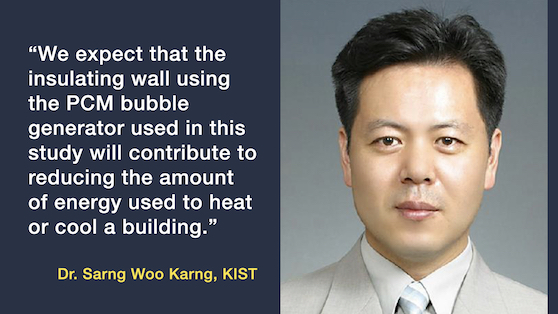
Commercial
Features
Industrial
Institutional
Phase change materials and bubble injections for heat-retarding walls
November 23, 2020 By Anthony Capkun
 Dr. Sarng-Woo Karng from the National Research Agenda Division, KIST. Photo © Korea Institute of Science and Technology.
Dr. Sarng-Woo Karng from the National Research Agenda Division, KIST. Photo © Korea Institute of Science and Technology. November 23, 2020 – A research team in Korea has developed a new material for buildings walls that can help reduce the penetration of heat from the outside.
Directed by Dr. Sarng-Woo Karng from the Korea Institute of Science and Technology (KIST), the team says they have successfully lowered heat penetration through building walls by applying a phase change material (PCM).
PCMs are materials that absorb or release heat from/to the surrounding area, but do not change temperature during phase change. One of the most common types is paraffin oil, used to make candles, explains KIST. A solid PCM absorbs heat as it transitions into liquid phase so, by using a case to hold it when it is in liquid phase without causing any leakage, it is possible to apply them to a building wall to block heat from entering inside.
The problem, however, is that PCMs do not melt evenly from the outside toward the inside during phase transition from solid to liquid, rendering them ineffective at controlling the indoor temperatures.
Karng’s team, however, addressed the non-uniform phase change by injecting bubbles into the bottom part of the PCM during phase transition, which enabled uniform circulation of the PCM in liquid phase. As a result, the PCM melted from the area closest to the building enclosure in a uniform manner, and heat penetration was inhibited across the building wall until the entire PCM melted.
“We expect that the insulating wall using the PCM bubble generator used in this study will contribute to reducing the amount of energy used to heat or cool a building,” said Karng.
Print this page